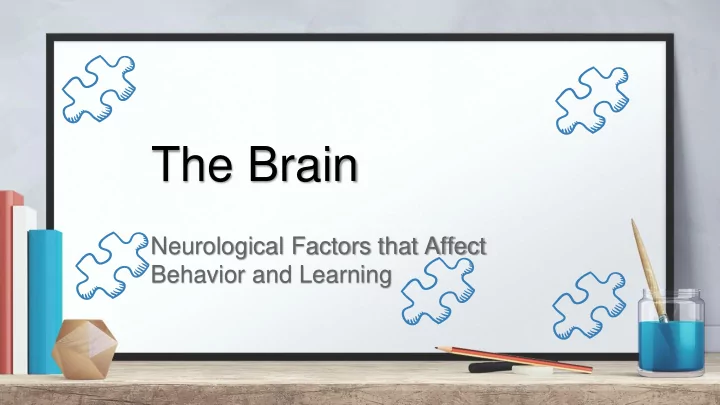

The Brain Neurological Factors that Affect Behavior and Learning
Hello! I am Layne Pethick Consultant for ASD and Behavior + at Region 10 ESC You can contact me at + layne.pethick@region10.org
Expectations for our time together… +Blanket Apology +Talking +Learning Two Main Rules for Spending Time with Me: +#1 - Enjoy yourself +#2 - You must have a sense of humor
Parents and Gardeners
Basic Agenda + The Brain + Something to Think About + Food For Thought
Let’s Begin It’s Me
Let the Layers Begin “Labels…labels…labels”
The Layers Build Labels antecedents BIP visuals programming LRE IEP
…and Build More labels… antecedents BIP visuals EBPs In-home programming LRE IEP
Through All the Layers and Labels… Even more labels… antecedents BIP visuals aggression trauma EBPs In-home FBA Non-compliant programming LRE IEP vocalization ABA …remember there is a child under there.
So…How Do We Begin to Look Beyond the Labels? • Looking beyond the labels and seeing the individual child is vital for decisions made regarding interventions, practices, strategies…life… • Today we will look at the BRAIN…the very thing that holds the key to all of our children!
Experts and Specialists… • Are you paying attention to the expert (the only expert that exists)?
It All Starts with the Brain! • How is the child’s brain processing information? • How do you begin figuring out the child’s brain? • Parents and teachers need to carefully select and “tweak” interventions, strategies, and practices to match the individual child.
First… The Brain
Brain Development +How our brains develop tends to be opposite of our education system and some parent expectations… + The human brain develops from the back to front…the education system and sometimes parenting is largely set up as front to back… +Educators and other adults have the ability to off set some of this opposition simply by the way they interact with children…
You are the surrogate frontal lobe!
The Brain and Attention + It is IMPOSSIBLE to “not pay attention”; the brain is ALWAYS paying attention +Attention is selective + Sustained attention to something you can’t understand is not only boring, but almost impossible…(think about instructional practices in classrooms)…human beings do not attend to or store meaningless information
The Brain and Emotion +Emotion drives attention and attention drives learning and memory Fixations…AKA “The window in…”
So What is REALLY Happening???
The Brain and Stress +Anxiety increases cognitive rigidity (my term: Stress makes you stupid) +Stressed adults = stressed children +BREATHE!!!
A Day in the Life
And now… +A TEST!!!
How Do You Feel? + What are your initial reactions to “the test”? + The more stress…the harder it is to deal with “life”
Spelling Test!! +Are you ready???
“ “Children have never been very good at listening to their elders, but they have NEVER failed to imitate them.” ~James Baldwin~
Something to Think About… Exclusive = Exclusion
Peers…The real world… +Peers
Food for Thought If We Have Time…
Function vs. Form +Addressing the FORM is only temporary +Addressing the FUNCTION is life changing +The function of the behavior is the motivation behind it or what is maintaining it…it is the answer to the question “WHY?” +The form of the behavior is the topography: what does it look like, sound like, how intense is it, how long does it last, how often does it occur **IMPORTANT – A behavior can have multiple functions
It’s All About the Data Data MUST be: Simple – easy, quick, and to the point Accurate – done with fidelity, Data honesty, and integrity Collect baseline data for minimum of 3 weeks (consider time of year also) Use data to make hypothesis on the FUNCTION of the behavior (Why is the student doing what they are doing?)
What does the data show? Patterns No Patterns (Socially (Automatic) Mediated) BEHAVIOR
Behavior Explained… Socially Mediated Positive Socially Mediated Negative (External) (External) *Someone else provides *Someone else removes a non- something that is preferred preferred or aversive Behavior Automatic Positive (Internal) Automatic Negative (Internal) *You provide something that is *You remove a non-preferred or preferred aversive
Behavior Needs to be Taught… Not just rewarded and punished… (move your clothespin…here’s your Skittle)
REMEMBER… It’s We don’t treat Me!! labels, we help the child!
Why I Do What I Do +Story
Thank You!
Recommend
More recommend